Barrio Barceloneta plus a special Thanksgiving guest.
Barceloneta is roughly triangular, bordered by the Mediterranean Sea, Port Vell, and the El Born neighborhood. We even have our own flag. I don’t know how many square kilometers big it is, but my guess is less than 5 (which would translate to less than 7 miles). The neighborhood is shaped like a big slice of Pizza – where we live is at the tip of the pizza, where the port and the sea meet. The neighborhood fans out from there.
The funky sculpture above, entitled ‘Homage to Barceloneta’ commemorates the old-fashioned shacks (barrancas) that once lined our beach. It has also come to represent the tiny apartments of our neighborhood, once home to pirates, fishermen, thieves and all trade related to the fishing or boating industry. They claim to be a “neighborhood of bastards”.
The morning’s catch can be bought on Calle Pescadero if you have good timing. This is like a throwback to the days of old. So does the below image of a grumpy knife sharpener who trolls the streets with his sharpening tools attached to the back of his motor scooter.
The average apartment in Barceloneta is 30 square meters, or approximately 100 square feet; tiny, and with low ceilings. Very few buildings have an elevator. Most have dark, narrow stairwells with lots of small, dark, tiny stairs intended for the diminutive foot sizes of the average (short) marinero. Years ago they would fit multiple big, extended families into these tiny homes. This way of life still exists here in some homes, and especially on some streets but on a smaller scale. Modern times laden with opportunities elsewhere gave some the chance to move away and make a new life for themselves somewhere else. The below photo essay will illustrate how this way of life persists today. Families extend their concept of home and claim the sidewalks outside their front doors. They are entitled to it.
At its core is a very simple but proud class of citizen that resides in Barceloneta. Their families have worked hard, scraped by and pooled their resources for many generations. Suspicious at first, my Catalan neighbors are fundamentally warm and generous. It helps that I’ve picked up conversational Catalan.
Most locals have become inured to “progress” and globalization, which they know is inevitable, however they stubbornly stick to their ancient traditions and ways of doing things.
We live on the beautiful, pristine Mediterranean coast, so it was only a matter of time before the rest of the world caught on. There are not many hotels here on the beach, and tourists are willing to pay outrageous prices for a month’s stay at a ridiculously small privately owned apartment near the beach. The inevitable changes brought about by tourism are to blame for the new dynamic between residents and tourists. Greed breeds hostility, and around 2006 (before the crash) prices soared. Some sold their apartments for 3 times what they were worth (which is pure profit if you originally inherited your place), some moved into town and turned their home into an illegal tourist rental flats, much more lucrative than the dying fishing industry.
We moved from Gracia to this neighborhood 8 years ago. We got our fixer upper for a great price, rennovated it and were happy there for 6 years. We’d still be there if it weren’t for the steps – all 88 of them. With no elevator, we stayed fit just by going out and having to climb the godawful 88 steps. But once home, it was so quiet – it was like living n a treehouse. Heaven. We were happy there. I posted many a blissful blog from our piso on Calle del Mar. But we always knew that someday before we got too old we’d have to sell the place and find one with an elevator…
The fact I have a dog and my own distinct style have made me a familiar and therefore friendly face to locals over the years. Some of the elders presume I’m Catalan, and I don’t correct them, seeing as its mostly “Quin dia mes bonic” (what a gorgeous day) or “Que goig que fas” (How great you look!”) No intellectual exchange of ideas takes place, just the daily niceties of being human together.
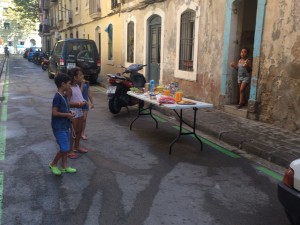
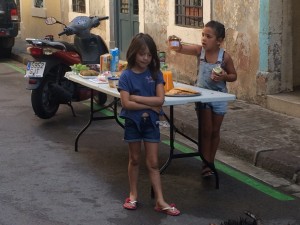
At first I thought these kids were selling lemonade on the street, but it turns out they are setting the table for the family meal on their extended sidewalk, just outside the front door (which invariably leads to a small den with TV and arm chairs inside).
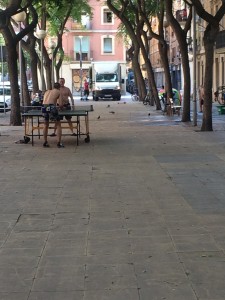 In the photo below you can see how they hide the table from public view behind lush potted plants just outside their front door.
In the photo below you can see how they hide the table from public view behind lush potted plants just outside their front door.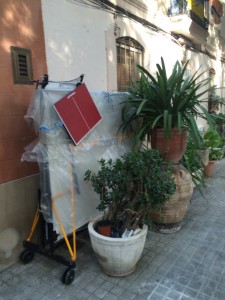
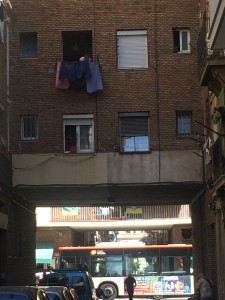
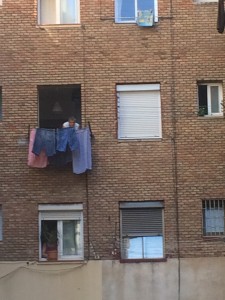
Walking to the bakery I Look up and am charmed by this very typical scene of everyday people living their peaceful lives. Awhile ago I did a blog from our former apartment called Balcony Life which captures another, more private view of life in this neighborhood.
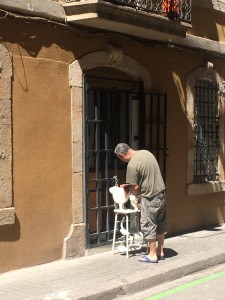
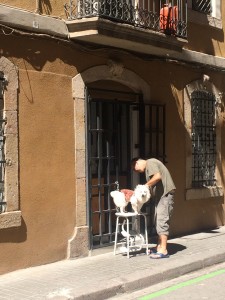
This guy uses his front porch-on-the-sidewalk to groom his dog. Most ground floor (bajo) apartments are tiny so it’s only logical for daily life to extend outside onto the street.
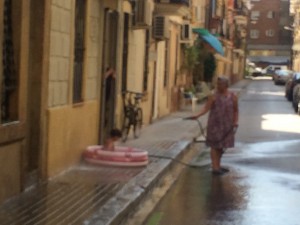
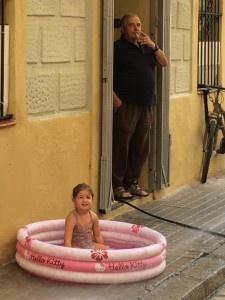
This family uses their sidewalk as a front yard for the kid to play in her pool.
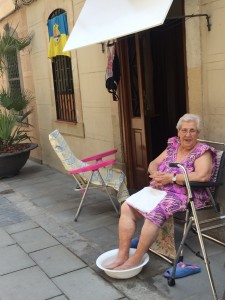
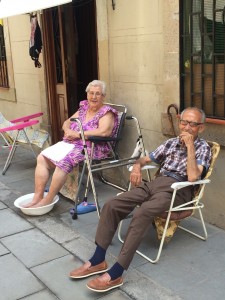
This lady soaks her feet and hangs out with her husband on their sidewalk.
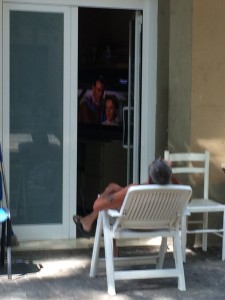
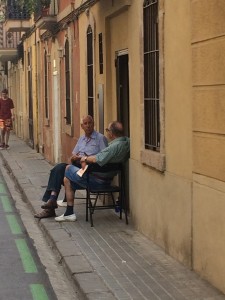
This guy has extended his den onto the sidewalk, from where he sits in his easy chair to watch TV while two old friends a couple doors down sit out front on the sidewalk to shoot the breeze.
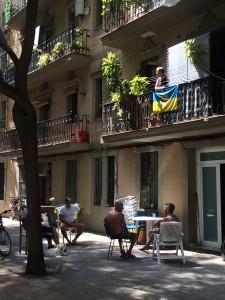
Residents just hangin’ out, playing cards, talking politics and shooting the breeze. Life here is relaxed.
†¥†¥†
The last 10 or 15 years has seen a slow, unstoppable, growing flow of tourism here. The many beachside bars and trendy restaurants and clubs attract rowdy football hoodlums and drugged out party animals, resulting in the ugly phenomena of drunk tourism, especially following UK/Spain matches. This is why many young visitors are unable to connect with the locals, for their more rowdy party time contemporaries have hardened many residents to all youth, even the more respectful ones. They are put up with rather than welcomed in our small community. If you are tall, blonde, British or Scandinavian they have no use for you.
<h3<The following anonymous street graffitti was painted over after several complaints:
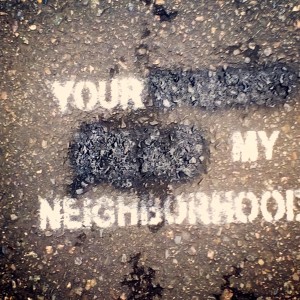
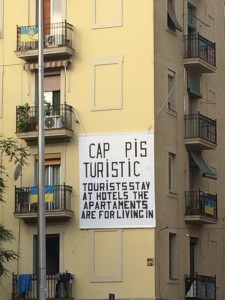
The last shot in the above sequence is a building near el mercado central has a banner which reads “Cap Pis Turistic” and means “no more tourist flats.” You will see variations of this banner hanging from many balconies. They are trying to encourage locals not to rent out their homes to tourists. They have nothing against tourists, but the nature of how this barrio is built does not lend itself to harmonious relations between partying travelers and the families renting the tiny apartment next door or below them.
The message of the above anti-tourist street grafitti and banners hanging everywhere could be interpreted as being rude and unwelcoming, and in fact many residents were embarrassed when the nasty spray panted messages appearing on the roads and had those immediately removed. But they feel a growing disgust with drunk tourists who scream and sing at the top of their lungs at all hours of the night and then piss on their doorways.
But on the other hand, the following banner reveals a more compassionate message, welcoming refugees. Refugees don’t get drunk and sing at the top of their lungs as they stumble to their next destination. Refugees are welcomed with a warm meal, with compassion, with respect.
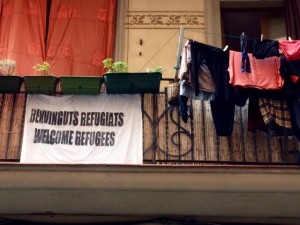
Part 2
Over the years the work of a local photographer has come to my attention. I’ve been collecting his yearly calendars (which my pharmacy gives to loyal clients every year) and love the images of gritty, everyday life so much that I don’t throw the calendars away at years end. I’ve also admired his work in the local neighborhood monthly paper. I thought to myself “I’ve love to meet this man someday” and made note of his name, Vicens Forner. When I saw in the local rag that he was having a show at the Barceloneta Civic Center, although I couldn’t attend the opening I made it a point to go check it out, and I was so impressed. His work is exceptional. A couple of his beach photos looked like they had been shot from our very balcony, which made me suspect he must have a friend in our building. His documentation of a neighborhood that is essentially very Catalan and hardworking, of the ever more fancy yachts and cruisers in the harbor that have replaced the funky trade vessels of his childhood, of the flux and flow of refugee African and Pakistani “manteros” (guys who sell cheap souvenirs, watches, knock off designer sunglasses, selfie sticks, hats, tapestries … you name it)
versus the local authorities is outstanding.
One day I did a facebook search for his name -and there he was! I requested his friendship, with a note telling him how much I admired his work. Of course he accepted. So I’ve been perusing his images on facebook for a couple years now. “Why haven’t I met this guy?” I asked Mark and showed him a selfie Vicens posted on facebook. “Have you seen him'”
“Not that I’m aware of”.
I memorized his image from the handful of photos of him on his facebook page and began the lookout. With his grey hair, mustache and glasses I failed to recognize him. I studied his selfies – average height, weight, nondescript clothes – it would have to be something like his camera hanging around his neck that would give him away.
One day a little over a months or so, when riding my bike with Quixote through the barrio I was charmed by an art class that had blocked off traffic on that quiet corner of San Carles and San Miguel so they could paint in aire libre. I stopped to take a couple snaps – when I noticed him – the famous Vicens! He was shooting the same event, but from another angle.
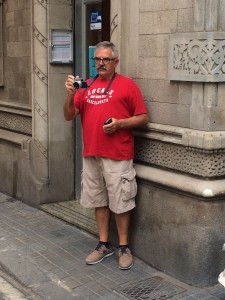 “Are you Vicens?” I asked him? He said yes. I introduced myself as a fan and facebook follower and how much I loved his documentation of Barceloneta. He seemed surprised and didn’t know how to react so I just said that I admired his timing, his subject matter, his original use of natural light, and the angles from which his he shoots his subjects. I didn’t want to embarrass him so Quixote and I continued on my bike ride without even telling him my name.
“Are you Vicens?” I asked him? He said yes. I introduced myself as a fan and facebook follower and how much I loved his documentation of Barceloneta. He seemed surprised and didn’t know how to react so I just said that I admired his timing, his subject matter, his original use of natural light, and the angles from which his he shoots his subjects. I didn’t want to embarrass him so Quixote and I continued on my bike ride without even telling him my name.
Fate has it that one day while relaxing on our ocean view balcony I looked over and lo and behold – Vicens was on the balcony of the apartment next door, in our building only in “Escalera A” (stairwell A) instead of “Escalera B”. How exciting!
When he saw me he waved in recognition. Mark looked over and said “El Famoso!” when he saw Vicens, for upon my suggestion he had recently started following him on facebook. We often discuss his photos, because they are a good way to find out what´s going on in the hood. There quite a few local festivals, openings, manifestations and cultural events going on in our neighborhood, and Vicens does a great job of documenting them. His commentaries are also always insightful and incisive.
After waving hello he went back into the apartment. “Maybe he’s shy” I said to Mark. “I hope we didn’t chase him inside.” Later we learned he has lived in our building in the apartment next door for over 30 years. Before that he and his family lived on the more humble street of Pescadero where he was raised.
Later that evening I made a daring (for me) overture by way of a direct FB message. I reiterated how much I respect his work, that I’m a writer of Italian/American descent who has been living in Barcelona for 10 years now and in Barceloneta for 8. After pushing send I wondered if I had been too forward… He seems a bit shy. But the next morning I woke up to a direct message reply telling me he’d like to give me a copy of his book about the neighborhood, and he would leave it for me in my mailbox.
Mailbox 3-1 I replied. That afternoon he left his book, with a written dedication to Monalia. I was touched and again honored.
I began reading his book, in which I learned he’s the 5th generation of a family that’s lived in Barceloneta since time immemorial, comes from a heritage of boat people, and inherited a store from his father’s uncle that sold parts for small fishing boats and related rig. I may have the facts wrong but what I understood is that he and his wife turned the place into a business across the street from us and next to the port called “Locals Only” which rents spaces for people to store their surf boards, boat gear and other clunky beach equipment. Cool! His wife pretty much runs the business.
Now that we’ve met I keep running in to him. He is very humble and generous. I know this just from our few encounters. I want to get to know him better, so we’ve invited him and his wife to Thanksgiving dinner this month.
The title of his book is Crónicas de L’Òstia – Barceloneta 1949-1992. I learned that Ostia is what locals call Barceloneta. The literal translation is “the host” the flat bread wafer given to Catholics at Holy Communion, but in Catalan it means something that impacts you either in a good way or a bad way. It can mean “amazing” or “unbearable” depending on the context. I can see how our barrio got that name; its a place that will definitely impact you in some way. Its not a place for cowards.
Since receiving his book about 2 weeks ago, I’ve noticed there are several businesses in the hood with the word Ostia which I’d never noticed before. Here’s a couple examples:
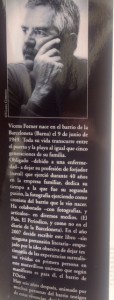
addendum 1
Here is my rough translation of the book’s description:
In the port were also concentrated many other smells. It was perceived as the hemp of the stacks (moorings), the tar, the sea, the fish, but especially the pitch. Those who have not smelled the tar can never understand what it is like to live in a seafaring neighborhood. The stores were always impregnated with that smell; Also the streets, the clothes of the sailors and, in general, of all those that had some relation with the port. The odors overlapped and confused, but we knew how to distinguish each and every one. Coffee, for example, was another port odor, stronger than the others and also more pleasant. When they unloaded coffee, they always lost a few bags that, in the end, were going to La Barceloneta at a very good price. Its essence flooded the streets. We can imagine five hundred kilos of coffee spread all over the neighborhood toasting in the houses and even in the street. The odor was pouring down to Barcelona, who was sure to suck with envy the scent of the lawless city.
addendum 2
Thanksgiving went as planned. A couple days before, I picked up the local paper and there was this article about my new friend, Vicens Forner, who received the medal of honor from the city of Barcelona for his neighborhood activism and work raising cultural awareness. Pretty cool.
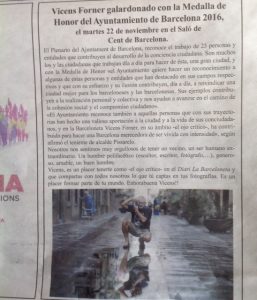
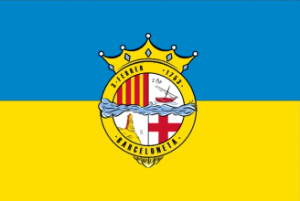
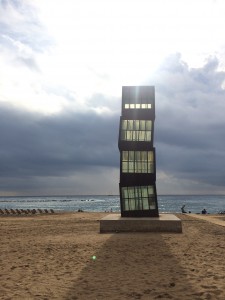
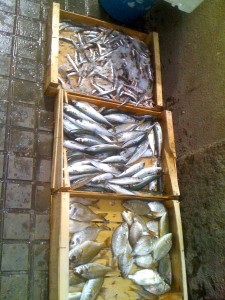
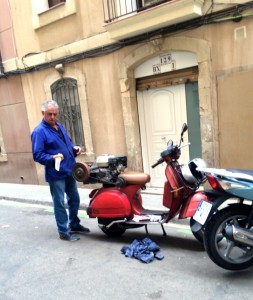
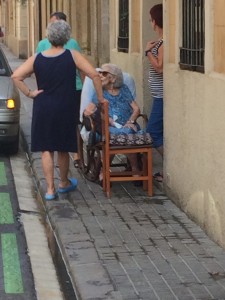
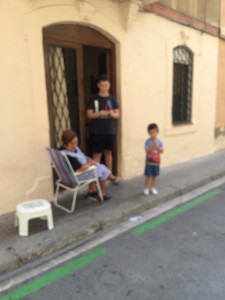
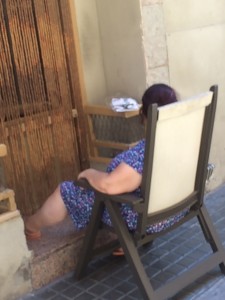
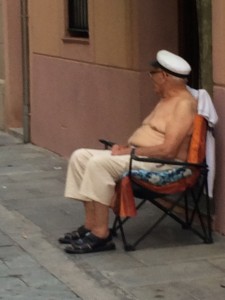
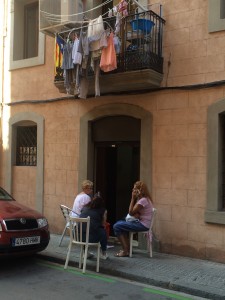
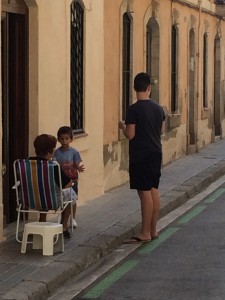
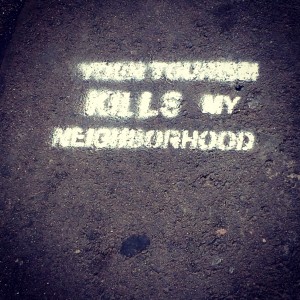
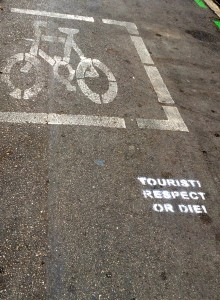
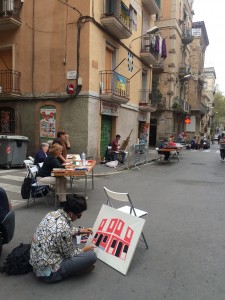
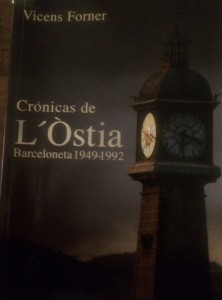
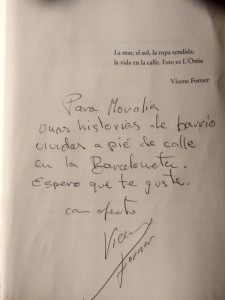
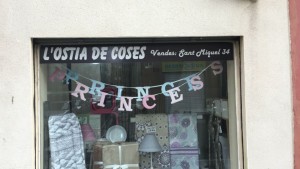



Recent Comments